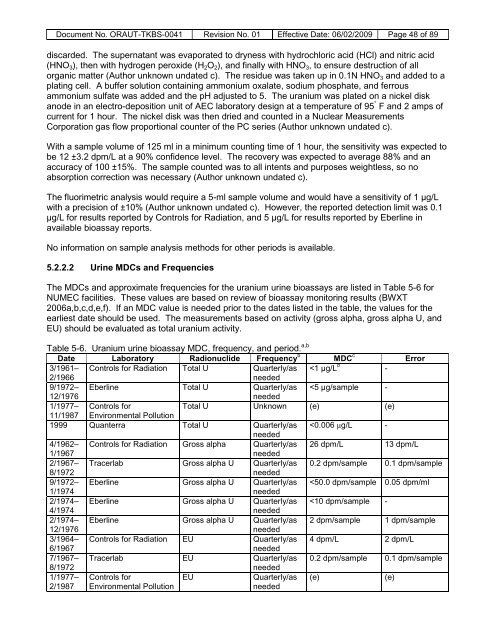ORAU TEAM Dose Reconstruction Project for NIOSH
ORAU TEAM Dose Reconstruction Project for NIOSH
ORAU TEAM Dose Reconstruction Project for NIOSH
Create successful ePaper yourself
Turn your PDF publications into a flip-book with our unique Google optimized e-Paper software.
Document No. <strong>ORAU</strong>T-TKBS-0041 Revision No. 01 Effective Date: 06/02/2009 Page 48 of 89<br />
discarded. The supernatant was evaporated to dryness with hydrochloric acid (HCl) and nitric acid<br />
(HNO3), then with hydrogen peroxide (H2O2), and finally with HNO3, to ensure destruction of all<br />
organic matter (Author unknown undated c). The residue was taken up in 0.1N HNO3 and added to a<br />
plating cell. A buffer solution containing ammonium oxalate, sodium phosphate, and ferrous<br />
ammonium sulfate was added and the pH adjusted to 5. The uranium was plated on a nickel disk<br />
anode in an electro-deposition unit of AEC laboratory design at a temperature of 95 ° F and 2 amps of<br />
current <strong>for</strong> 1 hour. The nickel disk was then dried and counted in a Nuclear Measurements<br />
Corporation gas flow proportional counter of the PC series (Author unknown undated c).<br />
With a sample volume of 125 ml in a minimum counting time of 1 hour, the sensitivity was expected to<br />
be 12 ±3.2 dpm/L at a 90% confidence level. The recovery was expected to average 88% and an<br />
accuracy of 100 ±15%. The sample counted was to all intents and purposes weightless, so no<br />
absorption correction was necessary (Author unknown undated c).<br />
The fluorimetric analysis would require a 5-ml sample volume and would have a sensitivity of 1 μg/L<br />
with a precision of ±10% (Author unknown undated c). However, the reported detection limit was 0.1<br />
μg/L <strong>for</strong> results reported by Controls <strong>for</strong> Radiation, and 5 μg/L <strong>for</strong> results reported by Eberline in<br />
available bioassay reports.<br />
No in<strong>for</strong>mation on sample analysis methods <strong>for</strong> other periods is available.<br />
5.2.2.2 Urine MDCs and Frequencies<br />
The MDCs and approximate frequencies <strong>for</strong> the uranium urine bioassays are listed in Table 5-6 <strong>for</strong><br />
NUMEC facilities. These values are based on review of bioassay monitoring results (BWXT<br />
2006a,b,c,d,e,f). If an MDC value is needed prior to the dates listed in the table, the values <strong>for</strong> the<br />
earliest date should be used. The measurements based on activity (gross alpha, gross alpha U, and<br />
EU) should be evaluated as total uranium activity.<br />
Table 5-6. Uranium urine bioassay MDC, frequency, and period. a,b<br />
Date Laboratory Radionuclide Frequency b MDC c Error<br />
3/1961– Controls <strong>for</strong> Radiation Total U Quarterly/as

















